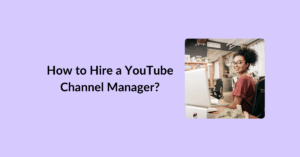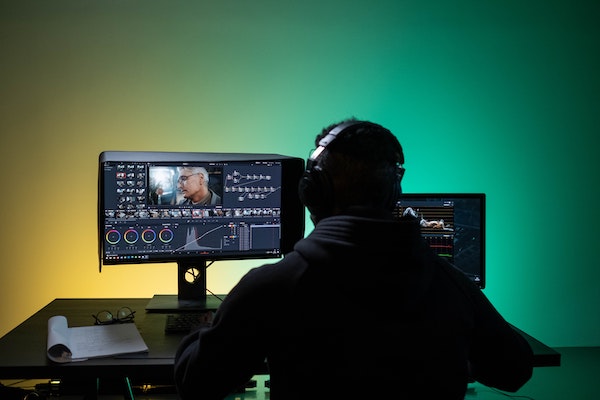Video making is a complex and scary process.
We bet you didn’t know that.
That’s because up until now, you’ve been led by guides that promise unreal things:
Create Flawless Videos in 3 Simple Steps
Professional Video Shooting Guide for Beginners
Videos Quick & Easy: 10 Minute Guide
The truth is:
- Shooting one-minute video demands hours
- Editing one-minute video demands industry knowledge
- There are a lot of re-dos involved
You cannot produce flawless video content in 10 minutes with zero experience, zero-knowledge, and free online video editing tools.
It’s true that using these unrealistic guides you can create something for your personal Facebook or Instagram account. But the making of any professional video content takes time, effort, expensive gear, knowledge, and experience. It demands input from your soul.
It’s difficult. But, of course, it’s not impossible.
In this guide, we’re going to walk through some realistic scenarios, potential problems that you’re going to face, and common mistakes to avoid. Along with this, we’ll guide you on how you can effectively approach your video mistakes.
There’s no formulated and definite solution. But there are best practices and possible solutions that we’ll be discussing. We need you to read further with a resolute mind. Your creativity and problem-solving skills will help you make the best of our video editing tips.
Table of Contents
7 Common Video Mistakes to Avoid
Every other amateur video creator makes the seven mistakes listed below. If you haven’t filmed your video yet, read carefully and watch out for the identified minor mistakes that could wreck the whole footage. If you’ve already filmed, we’ve suggested some ways to correct it. Let’s go!
1. Inconsistent Subject Audio
Your audience will stick to the video’s end if the sound quality is good and comprehensive. That’s true even if the visuals are a bit compromised. But if it’s the other way round, i.e., sound quality is poor, and the visuals are exceptional, your audience won’t stay.
For that very reason, when filming professional videos, arrange professional audio recording equipment. You can opt for any of the following mics:
- Lavalier Mic
- Shotgun Mic
- Standing Mic
A lavalier mic is tiny. You can clip it to the collar of the speaker. It’s available in both wired and wireless forms. We suggest it to beginner YouTubers and amateur filmmakers for short videos and vlogs.
A shotgun mic is also known as a boom mic. It works best when recording in public places as it eliminates surrounding noise. You’ll need assistance to use this mic as it is relatively big. It is attached to a pole and has to be pointed towards the speaker. But it shouldn’t be visible in the camera frame. Don’t expect your viewers to understand your shooting procedures and needs. It will come off as unprofessional.
A standing mic is visible in the camera frame. It serves best when recording or filming an event, such as a show or an interview. It’s good for corporate videos.
If you use these mics properly, you’ll be able to record in one to two tries. Plus, the raw footage will require less editing.
A few errors that you can’t fix:
- Sudden massive sound interruption. (Such as herds of goats scaring away a flock of birds, a sudden screech, or horn honking).
- Lots of ums, stutters, and mixed-up words.
- The missing voice of the speaker. (This is a problem for interviews. You can’t ask your guests to do a voice-over later).
- Inappropriate facial expressions and body postures of the speaker.
If you cannot rerecord, try these:
Possible Solutions
- Mute the recorded audio and do a voiceover.
- Collect recorded ambient noise and use it to fill between silent gaps between sound bites.
- Use online video editors to reduce background noise caused by poor-quality cords. Usually, it’s a 60Hz hum in the background. Even if your subject’s voice or music makes it barely audible, you ought to remove it because it’ll disrupt the viewer’s experience.
- Use highly specialized audio editing software for specific and big errors. However, you need to have the professional knowledge to use these.
2. Abrupt Transitions
Transitions refer to the shift occurring from scene to scene. These take the viewers smoothly and swiftly from one shot to another without disrupting their focus.
Some transition techniques used by video creators include:
- Fade In/Out
- Dissolve
- Wipe
- Zoom
Often beginner content creators make two common mistakes:
Mistake: They use a transition that’s longer than the previous clip.
Impact on the viewer: They may see a completely black screen before they get directed to the new shot.
Mistake: They use high-volume transitions.
Impact on the viewer: It will sound unpleasant, and they may turn down the volume. You will be unable to convey the information that you wish to deliver.
Both of these errors demand a blend of practice and creativity be fixed. You can try the following:
Possible Solutions
- Avoid using a different transition for every scene.
- Use online video editing tools to turn down the volume of transitions. Ensure that it’s the same as the main content’s volume.
- Use free online video editing tools to trim the length of video clips. Some tools offer drag-and-drop transition, which promises accurate and exact video length. Some will require manual trimming and cross-checking.
- Alternatively, hire an expert video editor to handle it all for you.
3. Using Dominating Music
Perhaps, the most common-est video mistake is settling for the wrong background music.
Remember, the supporting audio track can either draw your audience deeper into the video or push them away. So, choose wisely.
Here are some tips to help you pick the right background music for your video:
- Choose a track with a steady pace.
- Do not include narration and background music simultaneously.
- Use diegetic and non-diegetic sounds appropriately.
The upside here is that it’s very fixable. You can use any audio or video editing software to tone down the background music. If it’s an already uploaded video, we’re afraid there’s little that you can do. You’ll have to delete the video and upload the edited version, which will mean you’ll lose the stats.
However, if it’s a YouTube video, you can edit it in YouTube studio. Remove the original track and upload the newer fixed track. You can check out this guide to learn more about editing YouTube videos.
4. Bad Lighting
Go through this two-minute video that provides some quick examples of bad lighting. The video makes it very clear that lighting can change the whole mood and impact of your video.
So, be careful and avoid these four common lighting mistakes when making a video:
- Using lighting so low that it makes the viewer squint
- Using lighting so bright that it makes the user look away.
- Using bright lights with a white wall.
To avoid these, ensure that you balance your light sources well. Rehearse or record a short clip before shooting the entire video in the final setup.
In case things have gone dark already, you can use the following solutions:
Possible Solutions
- Use online video editors to balance exposure, contrast, and color temperature.
- You can use filters if you don’t know much about color balance.
- Use the video editors to replace the background.
- If you want a custom background, contact a professional video editor.
5. Improper Framing
At times, videographers record in improper frames intentionally. Usually, the thought behind this is “I’ll edit this later.”
Although it’s doable, it’s also equivalent to signing up for ten times the due work. So, it’s best to frame properly in one go. You can do this by using the rule of thirds. It divides your frame into nine boxes, creating a grid. Place your subject in any of the three central boxes (vertically).
Alternatively, you can opt for a theme and choose empty space intentionally. For example, if your video is about a lonely person, you’d want to include lots of empty space to give the impression and create the mood.
Another great tip for balancing is to avoid placing the camera at eye level. Instead, place it above or below eye level. Placing the camera at the character’s eye level makes the character appear neutral, which isn’t desirable in most cases.
Luckily, this is something you can handle even when things are already out of frame. Just trim, crop, or resize the video via any online video editor.
6. Recording a Shaky Video
Most videographers refuse to admit it. But the truth is your hand will get tired. You cannot replace the stability of a tripod with your hand.
Any attempts of doing so will result in a super shaky video that may cost you your viewership. So, to avoid the issue altogether, it’s best to use a tripod. It does not only eradicate the shakiness issue but also helps a great deal with framing. Having a stable view in front of you helps decide the best frame. Plus, it’s great for time-lapses.
If you’ve already recorded a shaky video, you can try the following:
Possible Solutions
- Use free online video stabilizers to remove the shakiness from the video.
- YouTubers can fix shaky videos for free on YouTube editor.
Note that these tools can fix overall shakiness. But for fixing super-specific seconds in shaking videos, you might require an expert’s help.
7. Being Unprepared
We repeat: video making is a complex and scary process. A lot of things can go wrong.
In fact, all things will go wrong. Video production is not as smooth as video planning. We’re not saying you cannot achieve the results you imagined while planning, but it will not be easy. You will have to conquer a lot of obstacles, last-minute problems, and even fight the dragons in your head (a.k.a. second-thoughts).
For that very reason, we recommend video makers stay prepared to deal with any unfortunate circumstances. Always keep a backup for equipment and locations. Check the weather beforehand and ensure you’ve booked your team for at least two days just in case you’re unable to complete it in one day. If your project will take a week for completion, book them for two weeks, and so on.
FAQ:
The best video editing software includes Adobe Premiere Pro, Final Cut Pro, Filmore, and CyberLink PowerDirector 365. However, the use of these demands professional video editing knowledge. So, we recommend investing in video editing services instead. Here’s a list of the best video editing services.
You send them our way! Expert video editors at editvideo.io can edit your videos with all the whistle and bells within 24 to 48 hours.
You can remove the graininess from a video using video editing software with noise filters. If it’s already uploaded, you can remove graininess by reducing the size of the playback window.
You can remove blur by increasing brightness levels and decreasing contrast. But if the video is highly out of focus, we recommend using rerecording or hiring professional video editors to artificially redo the video for you.
Try, try again!
Video making and editing can be both demanding and exhausting. But your vision is what you’ve to hold onto. Remember why you started and give it your best. The results will definitely be worth it!
And in case things get too complex and you feel you’ve reached a dead end, feel free to reach out to us. Our video editing experts have been through it all. They can pull you out of anything and anywhere. Good luck!




